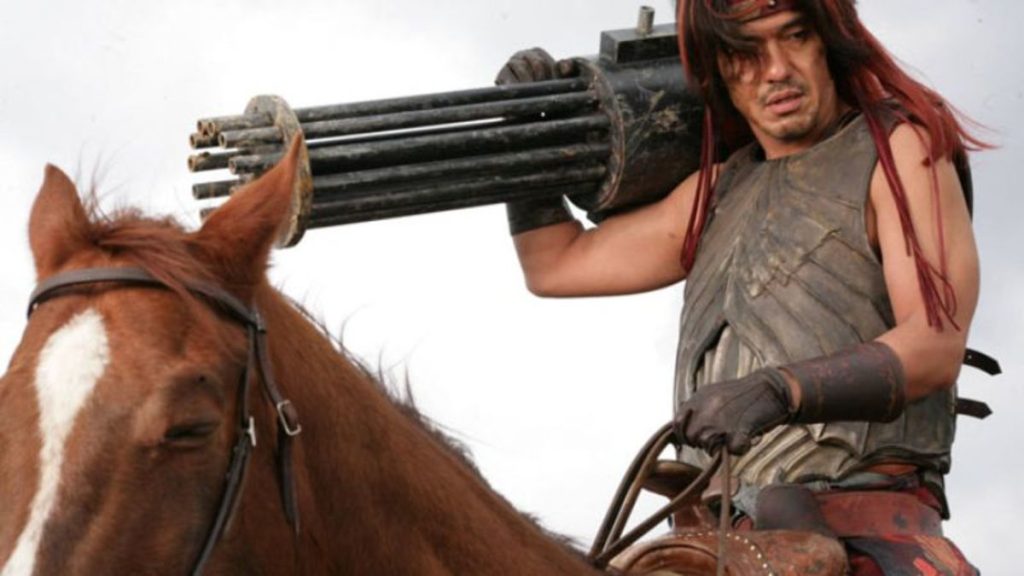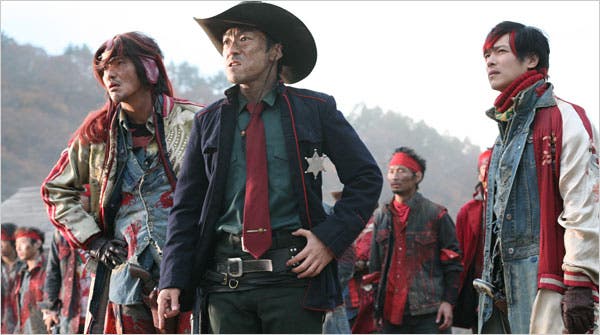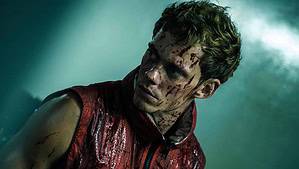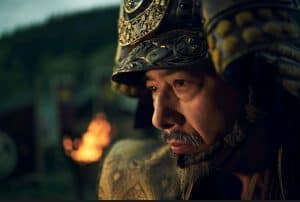Takashi Miike is one of the most iconic, controversial and prolific directors in modern world cinema. You can be forgiven if you are not completely caught up with his output considering he has been putting out multiple films a year for the past thirty years. Miike first gained international notoriety with films such as Audition, Dead or Alive and Ichi The Killer, for which he gained a reputation for being overly violent and obscene. While he certainly earned his criticism with some of his films, there are many interesting sides to Miike that are worth exploring. Sukiyaki Western Django finds Miike shaking things up and delving into the world of Spaghetti Westerns with a Japanese twist. The resulting film is over the top, zaniness that has some really fun action sequences and a style that is completely Takashi Miike.
The bones of Sukiyaki Western Django are a mixture of Akira Kurosawa’s Yojimbo mixed with Sergio Leone’s Dollars trilogy. The film uses the historical rivalry between the Genji and Heike clans as a launching point for this violent tale of revenge. In the fictional desert town of Yuta, Nevata, the residents have been driven away by the raging war between the white-colored Genji and red-colored Heike, who have flocked to the town to squabble over gold mining opportunities. When a nameless gunman (Hideaki Itō) arrives to town and displays his prowess with a pistol, the two sides vie for his allegiance to no avail. While he takes up shelter with an older woman, Ruriko (Kaori Momoi), he learns about the town’s bloody history and how the murder of her son led to her grandson becoming mute and her daughter in-law becoming a prostitute for the Genji in exchange for protection. The gunman agrees to help the family seek revenge against the warring clans, as events from his past make him empathetic to their plight. The story is covering well-trodden territory, but the execution is where the film really shines.
From the opening scene, the movie lets you know that you are in for a bloody fun time that takes place in a heightened reality where logic goes out the window. In a movie filled with almost exclusively Japanese actors, the first interaction we get is with director Quentin Tarantino showcasing his limited acting abilities on what is clearly a soundstage portraying the desert. We get a bit of setup on the history of the clans along with some brutal violence. While Tarantino inhabits only a brief part of the film, it is most certainly memorable every time he is on screen. The setting is more natural when we get to the main story, but the violence remains exaggerated with holes being blown clean through people to characters mowing down others with a Gatling gun. If you can sit comfortably through a Quentin Tarantino film, you should have no issue with this. The Original Cut of the film is paced especially well as you are taken on a kinetic journey filled with intense action sequences, moments of tragedy and triumphant victories.
One of the most unique aspects of the film is also something that is bound to be polarizing, depending on the audience member. As noted, the cast is almost entirely Japanese, but the film is presented entirely in English. Miike felt that telling this story of Old West vengeance would ring false if it was told in Japanese. Therefore, you have a lot of talented actors doing their best to struggle through a language that is not natural to them. The broken English can be a detriment at times, but it also adds to the blanket absurdity of the proceedings in a really interesting way. Performances would be way more natural in their native tongue, but that is not what Miike is trying to accomplish. He has meticulously crafted a vision for what he wants this movie to be, replete with lush production design and stylized cinematography. It is up to each viewer to decide if this is a journey they are willing to take with him. If you are like me, you will buy in to every absurd moment and delight in the violent character moments and predetermined character arcs. Sukiyaki Western Django is the unique brainchild of a director who is unafraid to make a movie exactly as he wants to make it.
Video Quality
Sukiyaki Western Djanjo arrives on Blu-Ray with a pretty stellar 1080p image. This transfer has a gorgeous filmic look rich with natural film grain and strong details throughout. The opening scene has a purposefully stylized look that might appear a bit worrisome at first, but the remainder of the film has a much lighter touch when it comes to the visual style. Black levels are very strong and yield a good amount of depth in shadows. Skin tones all look natural with subtle facial blemishes easily discernable alongside caked-on dirt and blood. Colors are quite vibrant and provide an appreciated vividness to the proceedings. Print damage and compression artifacts are virtually nonexistent on this release. Both cuts of the movie offer up the same level of greatness visually. Miike’s eye for composition coupled with a technically excellent disc makes this one a real stunner in high definition.
Audio Quality
The Blu-ray comes with a DTS-HD 5.1 Master Audio track that is incredibly impressive. The word of the day is immersion. The surround speakers get a real workout here with consistent activity in the rear and side channels from kinetic shootouts with bullets whizzing around you, as well as ambient noises from nature. The track sonically puts you right in the middle of the warring clans in a really satisfying way. Dialogue is balanced with great precision within the mix, but exact phrasing can be difficult to hear due to the nature of the production. The cast is almost exclusively made up of Japanese actors speaking English. Since English is their second language, some of the nuances can get lost in translation. The Original Cut comes with English SDH or Spanish subtitles, which I would suggest you using on your first viewing to get the lay of the land. The subtitles themselves leave a bit to be desired, as they are often presented either too slowly or too quickly to sync up with the exact dialogue on screen, and there are numerous formatting errors from spaces not being placed between words. The Extended Cut strangely only offers Japanese subtitles, so those who need English subtitles are out of luck on this version. While the subtitles are definitely imperfect, the audio presentation is top notch.
Special Features
- Sukiyaki Western Django – Extended Cut: The original extended cut of the movie is presented for the first time on disc in the US and in 1080p HD. This 2-hour cut adds an additional 23 minutes to the film that were cut by Miike for international release due to pacing reasons. After watching both versions, I can understand why Miike chose to cut certain plot points, but there are a lot of interesting character beats that enrich the film. There are good arguments as to why each version is superior, but I’m just thrilled to have the option to view the other version depending on my mood.
- Making Of Featurette: A 53-minute documentary that seems structured as a television special, which details the making of Sukiyaki Western Django. The featurette is presented in Japanese with English subtitles, and offers a great insight into the mind of Miike. The interviews with the actors are quite entertaining, as they endured a tough shoot and are not shy about bringing up unpleasant moments. None of them seem to be thrilled to be acting in English, but they knew it was a part of Miike’s vision. A very worthwhile piece of entertainment if you want to get some juicy behind the scenes details.
- Deleted Scenes: Nearly seven-minutes of deleted scenes are provided, which mostly consist of extensions of scenes already in the film. There is nothing that screams that it should have been left in the film, but there are some entertaining things here.
- Sizzle Reel: A three-minute video that is basically an extended trailer with text endorsements from acclaimed directors such as Guillermo Del Toro and Tarantino parsed out alongside action-packed clips from the film.
- Promotional Clips: Three-minutes of selected clips from the film chosen to help entice audiences to see the film. It is fun to see which ones they chose, but ultimately it is the same stuff you will find in the movie, but in lesser quality.
- US & Japanese Theatrical Trailers & TV Spots – Five-minutes of various trailers and spots that largely use the same footage, but formatted slightly differently. It is worth checking out for completionists who are itching to see how the film was marketed in different territories.
Final Thoughts
Sukiyaki Western Djanjo might be considered quite wild for those unfamiliar with the style of Miike or Tarantino, but established fans will gleefully accept the zany action oozing off the screen without question. The story has been told a thousand times, but the stylistic elements presented here are what make the movie special. It will not be for everyone; it makes bold choices and does not compromise. But those who are on the same wavelength will have an absolute blast with it. MVD Entertainment and FilmRise have provided a stellar A/V presentation along with an assortment of interesting extras, including the holy grail Extended Cut. This is a disc that you are going to want to pull out when you can start having friends over again. You owe it to yourself to add it to your collection. Highly Recommended
Sukiyaki Western Djanjo is currently available to purchase on Blu-Ray, DVD and Digital.
Note: Images presented in this review are not reflective of the image quality of the Blu-Ray.
Disclaimer: MVD Entertainment and FilmRise have supplied a copy of this disc free of charge for review purposes. All opinions in this review are the honest reactions of the author.
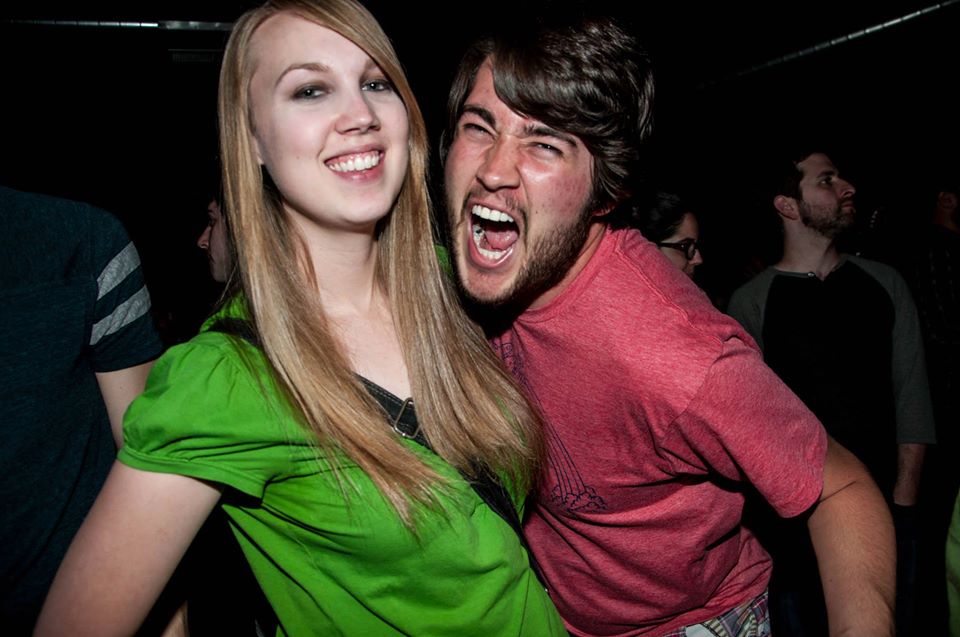
Dillon is most comfortable sitting around in a theatre all day watching both big budget and independent movies.


